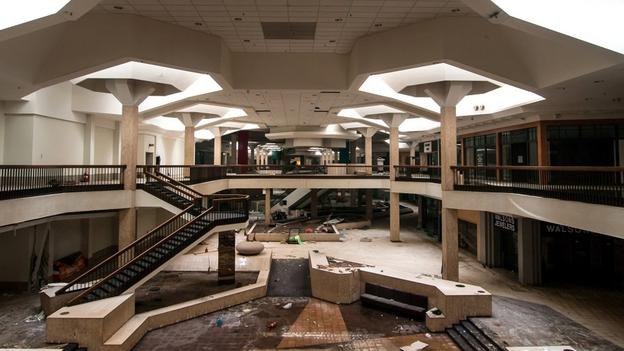
© architecturalafterlife.comRandall Park Mall, North Randall, Ohio
Shopping malls are not meant to be sinister. And, yet, in 1977, George A Romero chose to film sequences of
Dawn of the Dead, his cult horror zombie movie, in a deserted mall. Shorn of life and light, the great echoing chambers of the enclosed shopping centre took on a very eerie tone indeed. Curiously, Romero's set design has much in common with photographs of the ever-increasing number of abandoned malls strewn across the United States from California to New England. There are well over a hundred of these lifeless concrete and steel behemoths sprawled beside freeways on the fringes of far-flung American suburbs.
Economic decline in certain areas − notably the mid-West − combined with an accelerating trend towards online shopping and new forms of urban shopping centres have pushed the once seemingly invincible and all-American shopping mall into decline. Many are thriving, and being renovated and extended, yet 'ghost malls' are fast becoming the 'ghost towns' of the early 21st Century, and photographers have begun to see them as fascinating, if decidedly disturbing ruins.
Inside, their acres of kitsch design seem even sorrier than a seaside funfair out-of-season. All that marble, those wall tiles, the broad, Hollywood-like stairs − leading nowhere today − and sorry details like a sign on a wall of the Crestwood Court mall, St Louis, reading "Rest Easy", is both a little trashy and rather poignant.
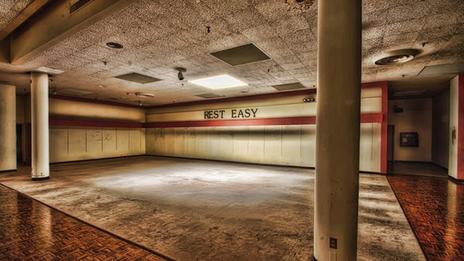
© danwampler.com'Rest Easy', Crestwood Mall, Missouri
All the more poignant, in fact, because the first US malls were not meant to have been sited miles from anywhere and reached only by big, air-conditioned automobiles with automatic transmission and power-everything. No, Victor Gruen, the 'father of the shopping mall' meant them to be the core around which new settlements would cluster, with apartments, clinics, schools and, one day soon enough, all the facilities and life that go together to make thriving urban settlements.
Born in Vienna in 1903, Gruen was a lifelong socialist who trained as an architect in his home city before abandoning it for New York at the time of the Nazi annexation of Austria in 1938. Gruen went on to design the world's first fully enclosed shopping mall, the Southdale Center in Edina, Minnesota. It opened in 1956, the year Elvis first broke into the charts, with Heartbreak Hotel, Norma Jean Mortenson changed her name to Marilyn Monroe, IBM invented the hard disk drive, and Fidel Castro and Che Guevara landed in Cuba.
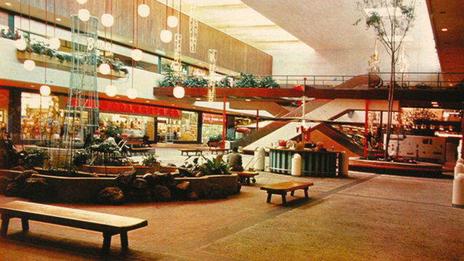
© mallsofamerica.blogspot.comSouthdale Center Mall, 1960s
Gruen's homes, schools, lakes and parks remained a pipe dream as Edina, Minnesota and, subsequently, the US as a whole went on a prolonged air-conditioned shopping spree in buildings that waxed ever bigger and yet more kitsch. The mall became a place to hang out as well as to shop, a central part of contemporary US culture and a model for much of the rest of a world keen on emulating an American way of life.
There had, of course, been malls of a sort long before the Southdale Center, beginning with Trajan's Market in Ancient Rome, built around 100AD by Apollodorus of Damascus, a Syrian-Greek architect and engineer, while the great souks of Aleppo, Istanbul and Damascus itself were nothing less than spectacular shopping centres. What was new about the US malls is that they were fully enclosed, inward-looking structures designed to be serviced by the car, encouraged by relaxed tax and planning laws and set in isolated locations.
In the mid-1990s, US malls were being built at a rate of 140 a year. The brakes went on in 2007, the first year in half-a-century that no new malls were built in America: recession had bitten deep into the US economy. Now, malls began to close, although some had become unpopular for reasons other than purely economic ones.
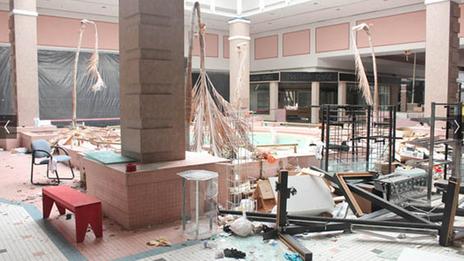
© architecturalafterlife.comCloverleaf Mall, Chesterfield, Virginia
When the 35-year-old Cloverleaf Mall in Chesterfield, Virginia, closed in 2007, the Chesterfield Observer noted that while it had been a popular hangout for families in the 1970s and '80s, "That all changed in the 1990s. Cloverleaf's best customers, women, began staying away from the mall, fearful of the youth who were beginning to congregate there. People [said a former Cloverleaf manager] started seeing kids with huge baggy pants and chains hanging off their belts, and people were intimidated, and they would say there were gangs."
The shopping mall had long lost its 1950s atmosphere of hedonistic, all-American innocence. And, as many became redundant, so they were abandoned like giant refuse thrown from even bigger automobiles. And, because they had been built on an increasingly ambitious scale and are essentially giant boxes with vast rooms inside shot through with miles of mechanical and electrical services, these were never going to be easy structures to convert to new uses, even though many Americans have suggested they become giant leisure centres: bowling alleys, funfairs and casinos. This is not such a bad idea: the demolition of such huge buildings could only appear to be a case of conspicuous consumption and wastefulness on a truly titanic scale.
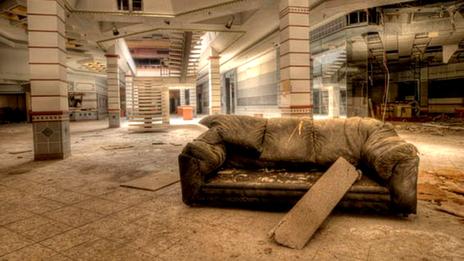
© architecturalafterlife.comRolling Acres Mall, Akron, Ohio
Today, the largest malls are in very different parts of the world. The biggest of all is the New South China Mall, Dongguan, covering a floor area twenty times that of St Peter's in Rome, and well over twice of the King of Prussia Mall in Pennsylvania, the biggest in the US. Among the top ten largest malls in the world are two, perhaps surprisingly, in Iran, while even Bangladesh with a GDP per capita of $1,851 boasts a new mall far bigger than Pennsylvania's "King of Prussia" (the same figure for the US is $51,749 according to the World Bank).
Shop horrorThe world has gone on a gigantic spending spree, and yet as the experience of America's 'ghost malls' shows, fashions do indeed come and go. Soon enough, and just as no one knows how to make use of Ancient Egyptian temples today, shopping malls will become the stuff of archaeology and folklore. A place for the living dead, too, perhaps, although the mall George Romero chose to film
Dawn of the Dead in - the Monroeville Mall, near Pittsburgh, opened in 1969 − is doing well. It was expanded and renovated in 2013-14, yet still revels in the roles it has played not just in
Dawn of the Dead, but in the 1983 movie
Flashdance, too, as well as in 1984's
The Boy Who Loved Trolls and in Steven King's horror novel,
Christine.
As a building type, and social and economic phenomenon, the shopping mall has a way to go, and yet it has already spawned its own wrecks and ruins. These tell us more than enough about the ways we have chosen to spend and live over the past half-century. Looking at photographs of abandoned malls, those ways can certainly be unsettling, and even just a little horrifying.
of vacant strip malls, visible from the roads, can been seen even in areas of the US that are more economically stable.
Growth of commercial property was booming in our small mid-Atlantic county until 2008, then quit abruptly. Since then there is a gradual increase in businesses closing and the buildings remaining vacant, to join the new buildings that were built but never occupied. The entire country is becoming a "ghost" of what it was. It the long run this may not be a bad thing--
we shall see.